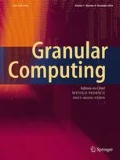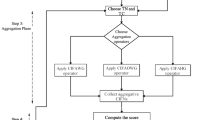Abstract
A complex fuzzy set, the generalization of fuzzy set provides a powerful mathematical framework whose membership degrees are in the form of complex numbers in the unit disc. The averaging operators consisting of the properties of both t-norm and t-conorm are of great importance in complex fuzzy environment. In this paper, we present certain quadratic averaging operators, including complex fuzzy weighted quadratic averaging, complex fuzzy ordered weighted quadratic averaging, complex fuzzy Einstein weighted quadratic averaging and complex fuzzy Einstein ordered weighted quadratic averaging operators. These operators are used to study many different issues of periodic nature. We apply these models to the multi-attribute decision-making problems and wireless detection of target location. Conclusively, we can choose the best opinion by the ranking of the aggregated outputs and detect the position and direction of a target. Moreover, we describe these models through numerical examples to check their validity and importance in real life problems. To explain the consistency and authenticity of our model, we examine a comparative analysis with existing aggregation techniques.



Similar content being viewed by others
References
Akram M, Dudek WA, Dar JM (2019) Pythagorean Dombi fuzzy aggregation operators with application in multicriteria decision-making. Int J Intell Syst 34(11):3000–3019
Alkouri AUM, Salleh AR (2014) Linguistic variables, hedges and several distances on complex fuzzy sets. J Intell Fuzzy Syst 26:2527–2535
Atanassov KT (1986) Intuitionistic fuzzy sets. Fuzzy Sets Syst 20(404):87–96
Bai SM, Chen SM (2008a) Automatically constructing grade membership functions of fuzzy rules for students evaluation. Expert Syst Appl 35(3):1408–1414
Bai SM, Chen SM (2008b) Automatically constructing concept maps based on fuzzy rules for adapting learning systems. Expert Syst Appl 35(1–2):41–49
Bi L, Dai S, Hu B (2018) Complex fuzzy geometric aggregation operators. Symmetry 10:251
Bi L, Dai S, Hu B, Li S (2019) Complex fuzzy arithmetic aggregation operators. J Intell Fuzzy Syst 36(3):2765–2771
Chen SM, Barman D (2019) Adaptive weighted fuzzy interpolative reasoning based on representative values and similarity measures of interval type-2 fuzzy sets. Inf Sci 478:167–185
Chen SM, Chang CH (2016) Fuzzy multiattribute decision making based on transformation techniques of intuitionistic fuzzy values and intuitionistic fuzzy geometric averaging operators. Inf Sci 352:133–149
Chen SM, Chen SW (2014) Fuzzy forecasting based on two-factors second-order fuzzy-trend logical relationship groups and the probabilities of trends of fuzzy logical relationships. IEEE Trans Cybern 45(3):391–403
Chen SM, Chu HP, Sheu TW (2012) TAIEX forecasting using fuzzy time series and automatically generated weights of multiple factors. IEEE Trans Syst Man Cybern Part A Syst Hum 42(6):1485–1495
Chen SM, Manalu GMT, Pan JS, Liu HC (2013) Fuzzy forecasting based on two-factors second-order fuzzy-trend logical relationship groups and particle swarm optimization techniques. IEEE Trans Cybern 43(3):1102–1117
Chen SM, Cheng SH, Lan TC (2016a) Multicriteria decision making based on the TOPSIS method and similarity measures between intuitionistic fuzzy values. Inf Sci 367:279–295
Cheng SH, Chen SM, Lan TC (2016b) A new similarity measure between intuitionistic fuzzy sets for pattern recognition based on the centroid points of transformed fuzzy numbers. Inf Sci 343:15–40
Cholewa W (1985) Aggregation of fuzzy opinions-an axiomatic approach. Fuzzy Sets Syst 17(3):249–258
Detyniecki M (2001) Fundamentals on aggregation operators. This manuscript is based on Detyniecki’s Doctoral Thesis
Dick S (2005) Towards complex fuzzy logic. IEEE Trans Fuzzy Syst 13:405–414
Dubois D, Koning JL (1991) Social choice axioms for fuzzy set aggregation. Fuzzy Sets Syst 43(3):257–274
Figueira J, Greco S, Ehrgott M (2016) Multiple criteria decision analysis. Springer, New York
Garg H, Nancy (2018a) Some hybrid weighted aggregation operators under neutrosophic set environment and their applications to multicriteria decision-making. Appl Intell 48(12):4871–4888
Garg H, Nancy (2018b) Linguistic single-valued neutrosophic prioritized aggregation operators and their applications to multiple-attribute group decision-making. J Ambient Intell Humaniz Comput 9(6):1975–1997
Gassert H (2004) Operators on fuzzy sets: Zadeh and Einstein. In: Seminar paper. https://pdfs.semanticscholar.org/a045/52b74047208d23d77b8aa9f5f334b59e65ea.pdf
Greenfield S, Chiclana F, Dick S (2016) Interval-valued complex fuzzy logic. In: Fuzzy Systems (FUZZ-IEEE), IEEE International Conference on IEEE: 2014–2019
Liu P, Chen SM (2017) Group decision making based on Heronian aggregation operators of intuitionistic fuzzy numbers. IEEE Trans Cybern 47(9):2514–2530
Liu P, Chen SM (2018) Multiattribute group decision making based on intuitionistic 2-tuple linguistic information. Inf Sci 430:599–619
Liu P, Teng F (2019) Probabilistic linguistic TODIM method for selecting products through online product reviews. Inf Sci 485:441–455
Liu P, Wang P (2018a) Some \(q\)-rung orthopair fuzzy aggregation operators and their applications to multiple-attribute decision making. Int J Intell Syst 33(2):259–280
Liu P, Wang P (2018b) Multiple-attribute decision-making based on Archimedean Bonferroni Operators of q-rung orthopair fuzzy numbers. IEEE Trans Fuzzy Syst 27(5):834–848
Liu P, Chen SM, Liu J (2017) Multiple attribute group decision making based on intuitionistic fuzzy interaction partitioned Bonferroni mean operators. Inf Sci 411:98–121
Liu P, Chen SM, Wang Y (2020) Multiattribute group decision making based on intuitionistic fuzzy partitioned Maclaurin symmetric mean operators. Inf Sci 512:830–854
Luqman A, Akram M, Al-Kenani AN, Alcantud JCR (2019a) A study on hypergraph representations of complex fuzzy information. Symmetry 11(11):1381
Luqman A, Akram M, Smarandache F (2019b) Complex neutrosophic hypergraphs: new social network models. Algorithms 12(11):234
Merigo JM, Gil-Lafuente AM, Yu D, Llopis-Albert C (2018) Fuzzy decision making in complex frameworks with generalized aggregation operators. Appl Soft Comput 68:314–321
Mesiar R, Komornikova M (1997) Aggregation operators. In: Herceg D, Surla K (eds) Proceeding of the XI conference on applied mathematics PRIM’ 96. Institute of Mathematics, pp 193–211
Pasi G, Yager RR (2006) Modelling the concept of majority opinion in group decision making. Inf Sci 176:390–414
Peng X, Yuan H (2016) Fundamental properties of Pythagorean fuzzy aggregation operators. Fundam Inform 147(4):415–446
Ramot D, Milo R, Friedman M, Kandel A (2002) Complex fuzzy sets. IEEE Trans Fuzzy Syst 10:171–186
Ramot D, Friedman M, Langholz G, Kandel A (2003) Complex fuzzy logic. IEEE Trans Fuzzy Syst 11:450–461
Seikh MR, Mandal U (2019) Intuitionistic fuzzy Dombi aggregation operators and their application to multiple attribute decision-making. Granul Comput. https://doi.org/10.1007/s41066-019-00209-y
Shahzadi G, Akram M, Al-Kenani AN (2020) decision-making approach under Pythagorean fuzzy Yager weighted operators. Mathematics 8(1):70
Shumaiza Akram M, Al-Kenani AN, Alcantud JCR (2019) Group decision-making based on the VIKOR method with trapezoidal bipolar fuzzy information. Symmetry 11(10):1313
Tamir DE, Last M, Kandel A (2013) The theory and applications of generalized complex fuzzy propositional logic. In: InSoft computing: state of the art theory and novel applications. Springer, Berlin, pp 177–192
Tamir DE, Kandel A (2011) Axiomatic theory of complex fuzzy logic and complex fuzzy classes. Int J Comput Commun Control 6:562–576
Tamir DE, Lin JL, Kandel A (2011) A new interpretation of complex membership grade. Int J Intell Syst 26:285–312
Teng F, Liu Z, Liu P (2018) Some power Maclaurin symmetric mean aggregation operators based on Pythagorean fuzzy linguistic numbers and their application to group decision making. Int J Intell Syst 33(9):1949–1985
Vanicek J, Vrana I, Aly S (2009) Fuzzy aggregation and averaging for group decision making: a generalization and survey. Knowl Based Syst 22(1):79–84
Waseem N, Akram M, Alcantud JCR (2019) Multi-attribute decision-making based on \(m\)-polar fuzzy Hamacher aggregation operators. Symmetry 11(12):1498
Wei G, Lu M (2018) Pythagorean fuzzy Maclaurin symmetric mean operators in multiple attribute decision making. Int J Intell Syst 33(5):1043–1070
Wei G, Zhao X, Wang H, Lin R (2013) Fuzzy power aggregation operators and their application to multiple attribute group decision making. Technol Econ Dev Econ 19(3):377–396
Yager RR (1988) On ordered weighted averaging aggregation operators in multi-criteria decision making. IEEE Trans Syst Man Cybern B 18(1):183–190
Yager RR (2004) Generalized OWA aggregation operators. Fuzzy Optim Decis Mak 3(1):93–107
Yager RR (2013) Pythagorean fuzzy subsets. In: Joint IFSA world congress and NAFIPS annual meeting (IFSA/NAFIPS) Jun 24 IEEE, pp 57–61
Yager RR (2016) Generalized orthopair fuzzy sets. IEEE Trans Fuzzy Syst 25(5):1222–1230
Yager RR, Abbasov AM (2013) Pythagorean membership grades, complex numbers and decision-making. Int J Intell Syst 28:436–452
Yazdanbakhsh O, Dick S (2018) A systematic review of complex fuzzy sets and logic. Fuzzy Sets Syst 338:1–22
Zadeh LA (1965) Fuzzy sets. Inform Control 8:338–353
Zhang X, Xu Z (2014) Extension of TOPSIS to multiple criteria decision making with Pythagorean fuzzy sets. Int J Intell Syst 29(12):1061–1078
Zhang GT, Dillon S, Cai KY, Ma J, Lu J (2009) Operation properties and \(\delta \)-equalities of complex fuzzy sets. Int J Approx Reason 50:1227–1249
Author information
Authors and Affiliations
Corresponding author
Ethics declarations
Conflict of interest
We state that there is no conflict of interest.
Additional information
Publisher's Note
Springer Nature remains neutral with regard to jurisdictional claims in published maps and institutional affiliations.
Rights and permissions
About this article
Cite this article
Akram, M., Bashir, A. Complex fuzzy ordered weighted quadratic averaging operators. Granul. Comput. 6, 523–538 (2021). https://doi.org/10.1007/s41066-020-00213-7
Received:
Accepted:
Published:
Issue Date:
DOI: https://doi.org/10.1007/s41066-020-00213-7




